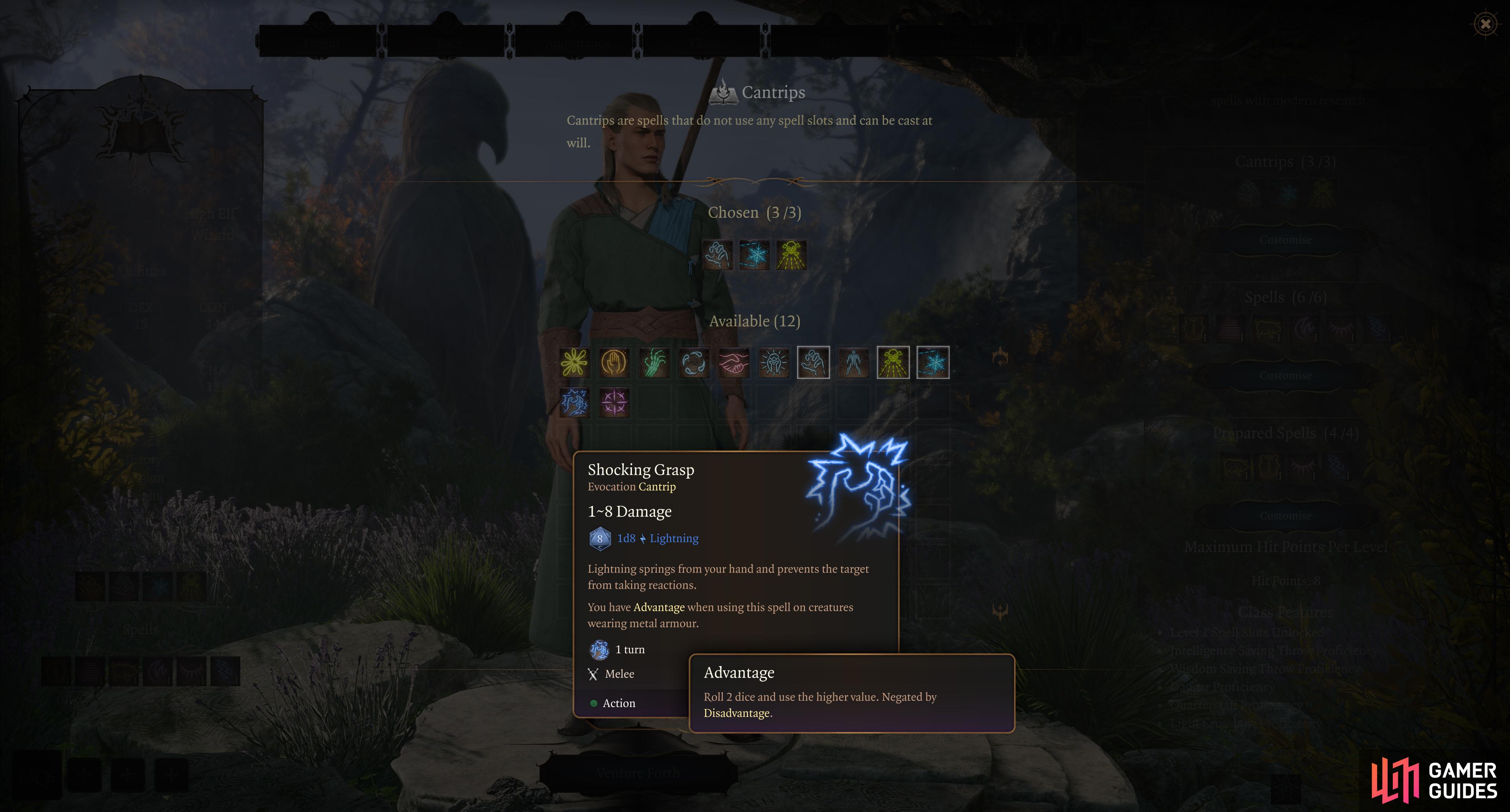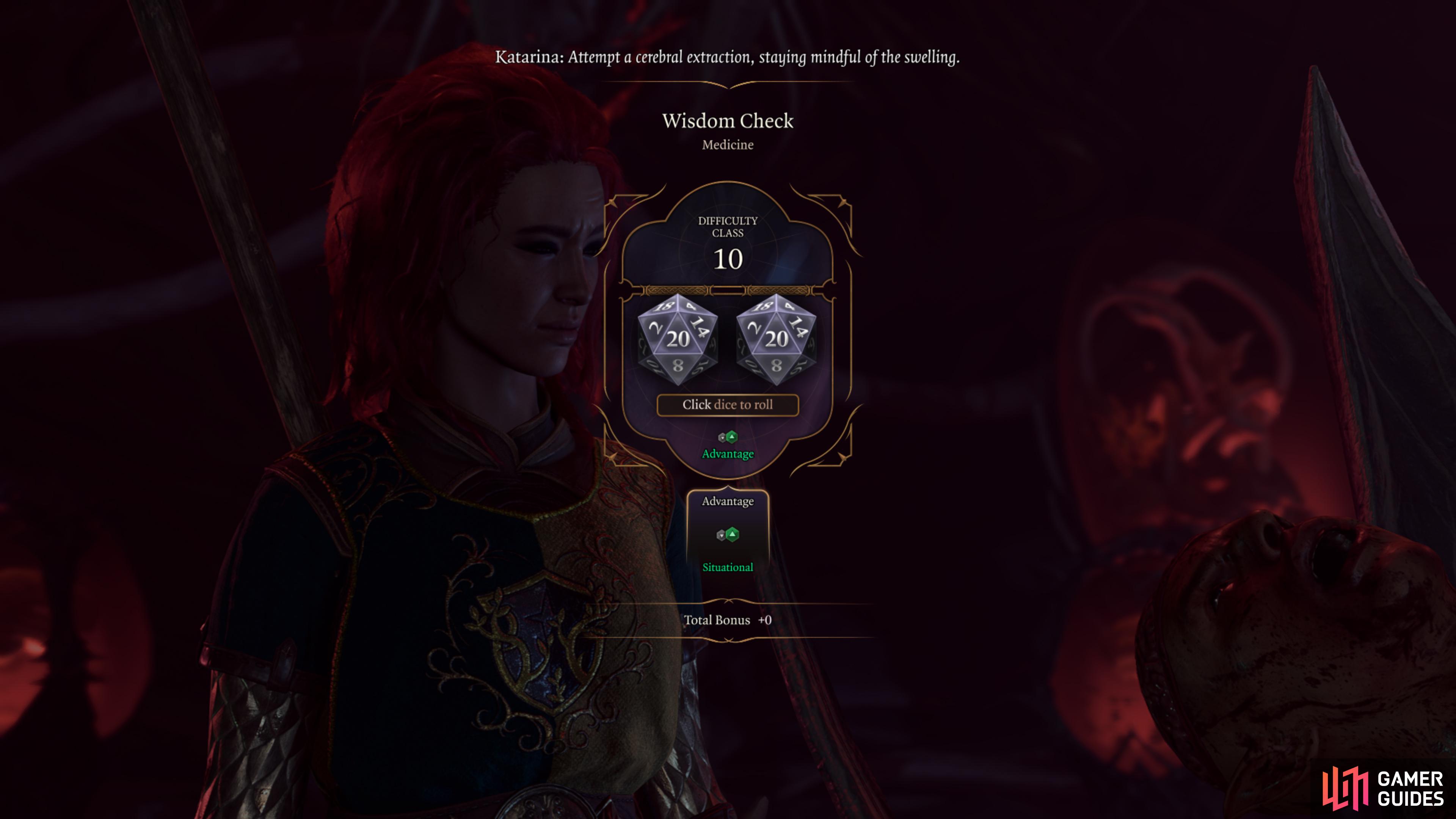There are numerous situations where one character can find themselves with an advantage or disadvantage over what the normal rules would grant, positively or negatively influencing the outcome of various checks. This page will cover the Advantage and Disadvantage mechanics in Baldur’s Gate 3.
You can gain Advantage or suffer Disadvantage from various sources - Attack Rolls made while casting Shocking Grasp, for example, have Advantage.
What is Advantage and Disadvantage?¶
In older versions of Dungeons and Dragons, various spells, feats, combat maneuvers and a myriad of other circumstances conspired to impose a wide variety of numerical bonuses or penalties to various checks. In 5th Edition Dungeons and Dragons, instead of various buffs and debuffs granting you bonuses to checks, they either provide Advantage or Disadvantage, respectively. Note that Advantage and DIsadvantage themselves are both a buff/debuff (albeit ones inflicted via various means) and a universal, simple system for resolving buffs and debuffs.
For example, in 3rd Edition Dungeons and Dragons, attacking prone characters used to give attackers a +4 bonus on melee Attack Rolls, attacking blinded characters gave attackers a +2 bonus on Attack Rolls, and Invisible characters gained a +2 bonus on Attack Rolls. In 5th Edition, instead of gaining the various bonuses above, you have Advantage in all three of those aforementioned scenarios. No need to memorize what effect gives what bonus, if it says Advantage or Disadvantage, you know what to do. Speaking of which…
What Does Advantage Do in Baldur’s Gate 3?¶
When you have Advantage on a check, you roll two d20 and keep the higher of the two results. All other aspects of the check are the same - you apply the same Proficiency bonuses and Ability Score modifiers as usual. The lower d20 result is disregarded entirely. For example, assume a 1st-level Fighter with 14 Strength is attacking a Blinded enemy with a Longsword - a situation where said Fighter has Advantage. They’d roll two d20 and apply their Proficiency (+2) and Strength modifier (+2) to both d20 rolls. One d20 rolls a 6 (+4), and the other rolls a 14 (+4) - they discard the 6 roll and keep the 14, which counts as their Attack Roll.
Below are some situations where Advantage is applied:
- Dwarves and Strongheart Halflings have Advantage on Saving Throws against poison.
- Elves and Half-Elves have Advantage on Saving Throws against Charm effects.
- Attack Rolls against a blinded, paralyzed, petrified, prone, stunned, unconscious, or otherwise restrained enemy have Advantage.
- Attack Rolls made by a hidden (successfully using the Sneak skill) or Invisible characters have Advantage.
- Charm Person grants the caster Advantage on Ability Checks in dialogue made against the afflicted character.
When you have Advantage or Disadvantage, you roll two d20 and keep the higher of the two rolls (Advantage) or the lower (Disadvantage).
What Does Disadvantage Do in Baldur’s Gate 3?¶
On the debuff side of things, when a character has Disadvantage on a check, they roll two d20s and must take the lowest of the results. Like with Advantage, you still apply all the normal modifiers, including your Proficiency Bonus and Ability Scores, but the higher d20 roll is disregarded. In the example above, the 1st-level Fighter with 14 Strength is now blind, and suffers Disadvantage on their Attack rolls. If they attack, they’d roll two d20s and apply their Proficiency (+2) and Strength modifier (+2) to both d20 rolls. One d20 rolls a 6 (+4), and the other rolls a 14 (+4) - they discard the 14 roll and keep the 6, which counts as their Attack Roll.
Below are some situations where Disadvantage is applied:
- If you wear armor you’re not proficient in, you’ll suffer Disadvantage on all Ability Checks, Saving Throws and Attack Rolls involving Strength and Dexterity.
- All characters suffer Disadvantage on Stealth Checks when wearing Padded Armor, Scale Mail, Half Plate, or any heavy armor.
- You suffer Disadvantage while making Attack Rolls with ranged weapons when you’re threatened by a melee combatant.
- Attacks Rolls made by blinded or prone characters and Attack Rolls made against invisible characters suffer Disadvantage.
- Exhausted characters may suffer Disadvantage on Ability Checks, Attack Rolls and Saving Throws.



 Sign up
Sign up

No Comments